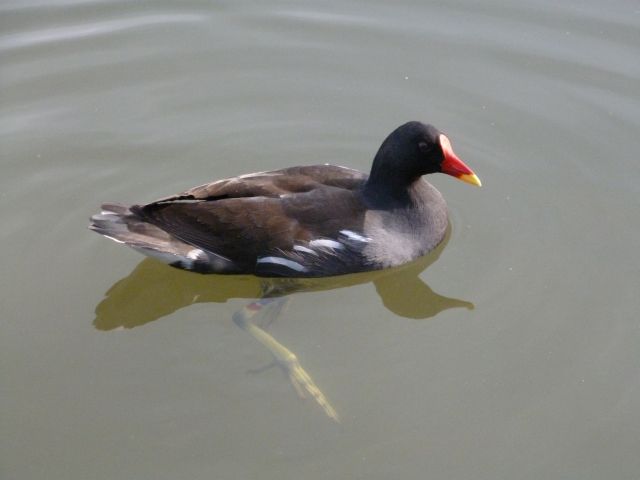
Cruising Notes
We stayed in the Milton Keynes area for a few months to re-furbish the inside of the boat. Mostly a question of cleaning down the varnish, or stripping it completely, and re-varnishing. It should not have been the most challenging task but the weather was being somewhat uncooperative. Either raining so that we could not use varnish without doing a fair share of solvent sniffing, or having a temperature of over 30C in the cabin (even with the doors open) meaning that the varnish dried somewhere between the brush and the woodwork.
Judy helped bring up a family of Moorhens, mostly by feeding them bread at regular intervals, and they eventually got used to flying up onto the gunwale to get the food themselves. For some reason whenever Judy does that I name the moorhen Pavlov.

The very moorhen that trained Judy to feed it's family
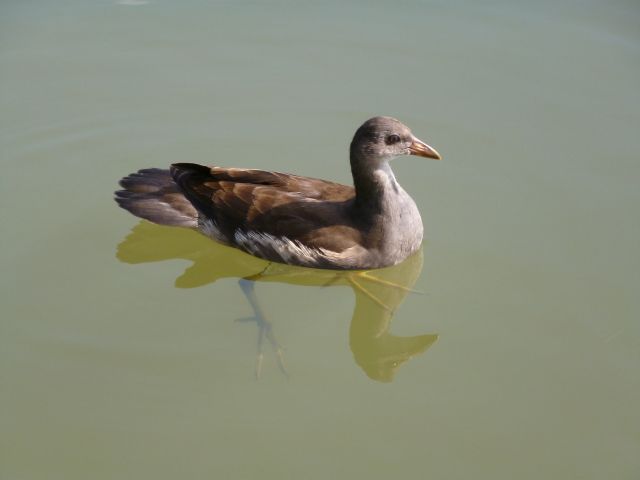
and one of their adolescents
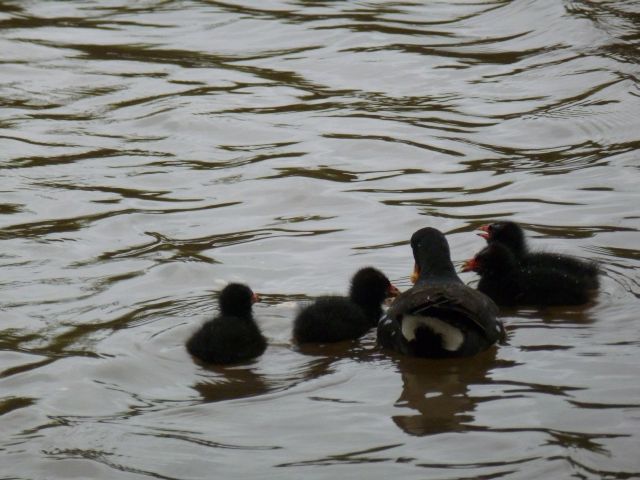
This is what they look like as chicks, simply balls of black fluff
Milton Keynes has it's charms, as a town it is very open, with lots of grassland and trees. Some of the moorings are superb (and we don't have to look after the garden).
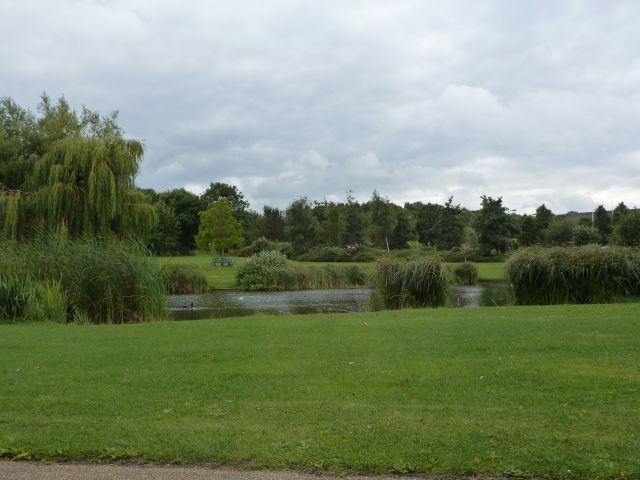
The
view from the mooring at Campbell park (Milton Keynes)
Milton Keynes has a lot of semi-legal residential boaters. This was a neat idea that someone has come up with to stop other boaters encroaching on their favourite bit of bank.
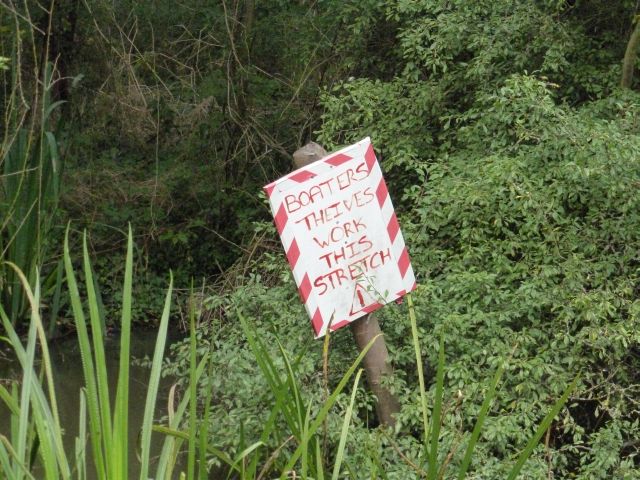
Then there was the guy paddling from Birmingham to London in a bath for charity. We gave him some charity, a warm bed overnight and some hot meals. I think he deserved it.
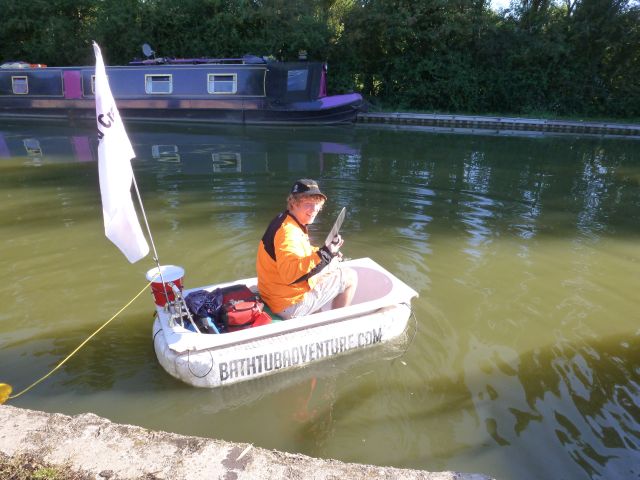
However things sometimes happen on the canals, it's not all peace and tranquillity like the adverts show. In this case it was a breach in one of the canals, luckily far from us. This is what it looked like. We need to pass this bit of canal on our cruise next year.
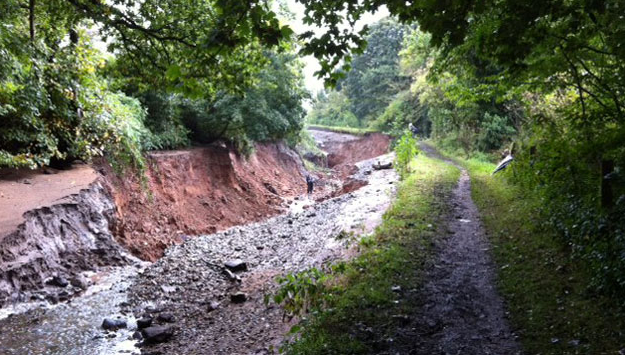
Lots of boats were stranded, as the old saying goes, it can ruin your whole day. They, the people who have to fix, it think that it could re-open in March.
It is part of the strange world that we live in that this event wiped out the television signal for thousands of people as the glass fibre signal cables ran under the towpath. The reasoning is that it's cheaper to dig up a towpath than a road to lay cables.
So, having done what we could in Milton Keynes we went to re-trace our route to Ely for the winter. It has been a particularly wet summer and there was lots of water in the river. Certainly enough for us to change our normal, somewhat lazy, procedures to ultra safe ones to ensure the safety of both ourselves and the boat, it is after all our only home. It was a cautious, but uneventful trip to Peterborough. Then things started to go wrong, the butcher who sold some of the best goat meat I have had in this country had stopped selling goat meat. It seems the Caribbean immigrant population have moved away to make room for the Eastern European population.
Then we found a group on our mooring (we were the only boat there at the time) who looked to be fishing, but weren’t. I went out, said hello to them but got no answer. So I took a bag of coal down, reached just inside the boat for a serrated knife I keep handy and slashed the top off the coal bag and filled the coal hod. They had seen enough and started to leave but as they departed, they set the boat adrift. It was no big deal as we were in a lagoon off the main river but before we got out of the cabin a couple of guys having a quiet smoke of cannabis were hauling the boat back to the mooring. Ten out of ten for the druggies!
We had no more trouble from them as the Environment Agency (responsible for the river) lowered an upstream sluice by 4 foot the following morning. The boat rose and jammed under the mooring but I got it free by the simple expedient of reversing the boat. The water kept on rising and when it got to within six inches of the boat floating over the mooring I called the downstream lock keeper where the water flows into the sea. He told me that they had lowered the sluice and that he could not get rid of the water as it was high spring tides, and I should prepare to be flooded.
I set up for a flood, basically holding the boat away from the mooring as when a boat floats over the mooring there is no problem, when the water recedes you are either left stranded on the mooring, or the boat can roll over if one side is on the mooring. It took three days and nights to empty the river and lake complex above the weir and to get the water out to sea. In my opinion, a man made flood for no good reason as the capacity of the lake system is huge.
Some pictures:
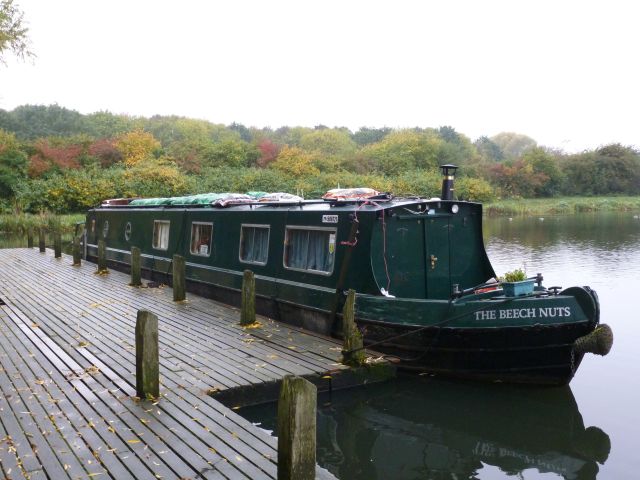
This is approximately what the mooring should look like. Normally the water is about a foot lower.
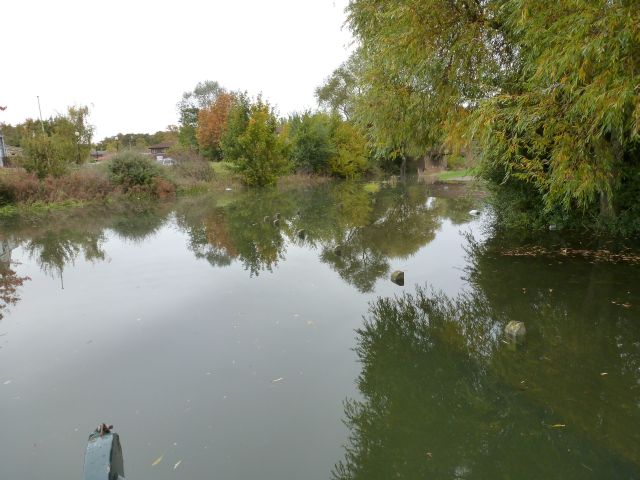
And this is what it did look like, you can see the front of the boat, and the line of the tops of the mooring pasts. To the bottom right you can (just about) see the mooring. Naturally this was taken from the boat as neither of us fancied getting wet, waist deep, just to get a good photo.
As regards our flooding measures (apart from living in a boat which is a good start), It looked a bit like this:
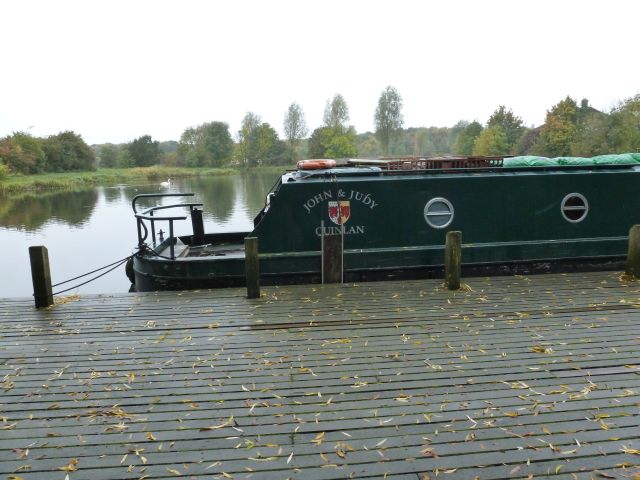
You can see our landing plank,hanging down from the boat
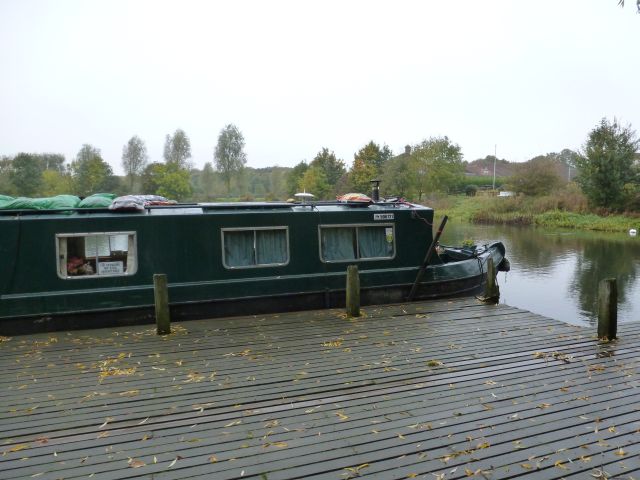
At the front, a single piece of wood to stop the boat going over the mooring (it works better than it looks). That piece of wood is over 12 ft long. The rest is just remaining very viligant. There are plenty of bits on a boat like ours that can catch when going up and down as it is designed for canals which don't, as a rule, do that. We did have a backup plan, simply to move into the middle of the lagoon and drop anchor. That involves turning to Mecca and praying several times a day that the wind stayed both light, and from the same direction as the combined length of the boat, anchor rope and chain would give us a huge radius to swing around in.
The waters started receding after 3 days and on day 4 I decided it was navigable, this was our chance to get off of this particular river and we took it. Unheeding of the Environment Agencies advice that no craft should move we headed for the lock to the Middle levels and managed to squeeze into the lock with a half inch headroom to spare (that is really tight in a boat) and reached safe water.
We normally cross the Middle Levels in a leisurely fashion but having called the lock keeper at the next tidal section we were told to be there in 3 days, after that there would be no passage for a further 5 days due to neap tides not giving enough depth in the tidal river. We were there in 3 days and made a totally unspectacular crossing onto the non-tidal section of the river Great Ouse.
I have written the last few times about boating against the advice given out by the “authorities” and even got a few emails about “living dangerously”. Well this is what happens when you get it wrong.
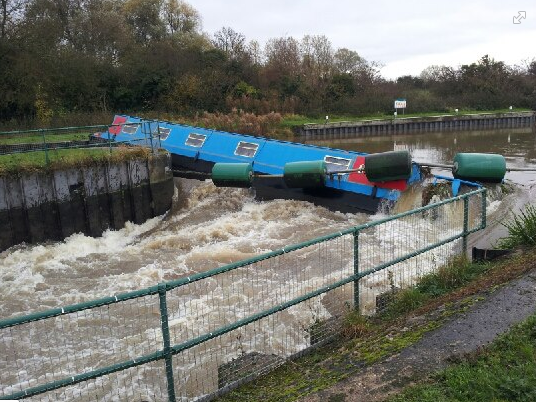
The people got off OK, the boat ended up well and truly sunk. We
really do play for keeps. Several times I have pulled in and moored when the
river was "safe" as I considered it was getting too dangerous, and many times
"they" have classed it as unsafe but I have been unable to see why. Some clues
to this are in the article I wrote (see below). Some of it is the "nanny state"
we have over here, but most of it is that the people passing out this advice
simply don't know much about real life boating.
We came through this lock a few days before this happened. It prompted me to write to a well known inland boating online news site.
If you want to read the article it is here but unless you are a UK boater it probably won't make too much sense:
http://www.narrowboatworld.com/index.php/news-flash/5059-meaningless-strong-stream-advice
However, once across the tidal bit we meandered our way to the Ely area only getting mugged en route by a few geese who mistook us for a fast food resturaunt. We invited them all to dinner but they all declined.
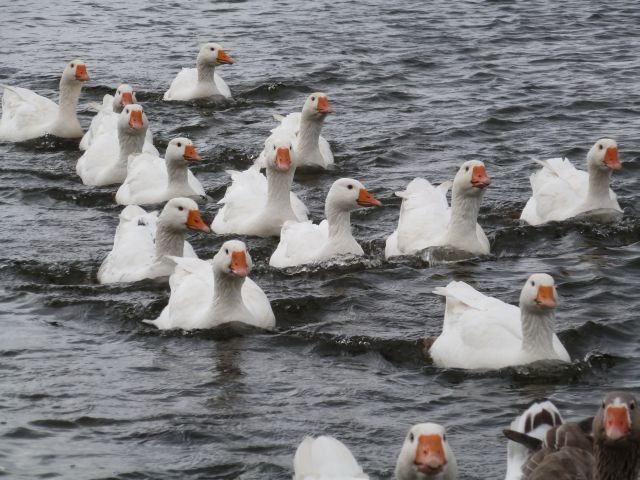
So we are back in the land where kestrels hover riding the updraught from the river banks, F15's scream and crackle overhead, swans patrol their moorings and the wind is not called maria, or any other polite name.
We are now in the normal business of sorting out, and improving the boat, getting our yearly checkups and sorting out our physical ailments and re-stocking the boat with consumables and spares ready for next years foray. We are quite safe from the floods ravaging the country at the moment, in fact we are on the only bit of river, that I know of, that goes down when it rains. We are 10-15 miles from the sea lock on a wide stretch of river. When rain is expected the lock keeper lowers the water level in the river to accomodate the extra water coming down. A few boats have ended up sitting on the bottom as he can get a bit enthusiastic at times.
There seems to be a little more drama in this set of notes than normal so to keep it up a bit of youtube video showing why boats need to be insured:
There are many moments that make all this boating malarky worthwhile. This was one of them.
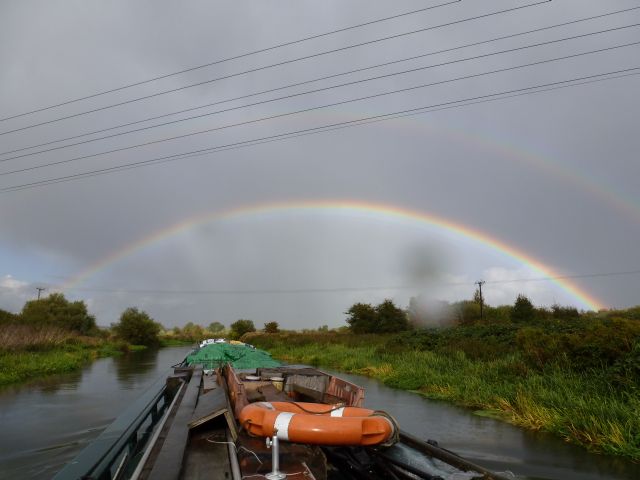
Have fun!
John